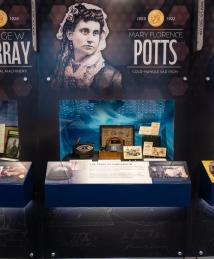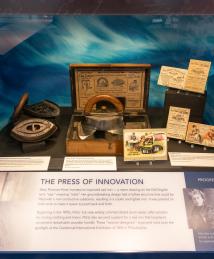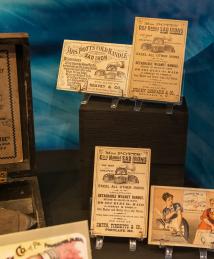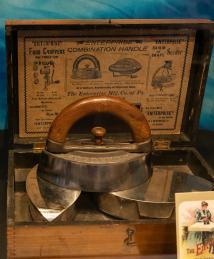Mary Florence Potts
Mary Florence Potts invented an improved sad iron, which was lighter and offered a cooler, more ergonomic handle. Beginning in the 1870s, it was widely commercialized as an easier, safer solution for ironing clothing and linens.
Born Mary Florence Webber in 1850, Potts grew up in Iowa. At the time, sad irons — named from the Old English “sad,” meaning “solid” — were cast entirely in solid metal. The invention of the cast-iron cook stove in the 1820s, which made it easier to heat irons, had helped popularize their use. As one iron cooled, another could be taken off the stove. However, these early irons cooled quickly, so it was necessary to own and heat several at once.
Another disadvantage of standard sad irons was that the handle was attached to the base and would also become hot. Users needed to wear a heavy glove or use a potholder to handle the iron, and they often suffered burns and blisters. Additionally, the iron was exceptionally heavy. While an early improvement offered a lighter wooden handle, the handle often charred during the heating process, weakening its structure.
Potts was married and raising a young son in Iowa when she began developing a series of needed improvements to the sad iron. Her hollow design could be filled with a substance that did not conduct heat, like plaster of Paris or cement. This resulted in a cooler, lighter iron. Her design was also pointed on both ends, making it easier to push back and forth. The bottom and ends of the iron were thicker, allowing the heat to radiate where it was needed most, and because Potts’ design held heat longer, it allowed users to iron more items without the need to reheat.
In 1870, Potts patented a wooden-handled sad iron with each of these improvements. The following year, she patented a sad iron with a wooden handle that could detach from the iron as it sat on the stove. This allowed the user to work with a cool handle while additional iron bases were left to heat up on the stove. These improved irons were featured at the Centennial International Exhibition of 1876 in Philadelphia — the first official World’s Fair held in the U.S.
Potts lacked the financial resources to manufacture and sell her invention on her own, so she began working with third-party manufacturers. Marketing the invention as Mrs. Potts’ Cold Handle Sad Iron, the manufacturers promoted the fact that a woman had designed it.
The new sad irons were sold as a set including three irons, one handle and a stand. One iron, suitable for light work, weighed 4 pounds and had one round end for polishing or glossing. The second, intended for general use, weighed 5 pounds. The third iron ,weighing 6 pounds, was designed for tablecloths, sheets and other large linens.
Potts held a total of seven U.S. patents. When patent rights expired in the 1890s, many ironworks began to copy Potts’ original sad iron design, and some advertised it as the Mrs. Potts Iron. They were commonly used well into the 1930s, at which point they were surpassed in popularity by electric irons. Today, Mrs. Potts Irons are sought after by antique dealers and collectors.






